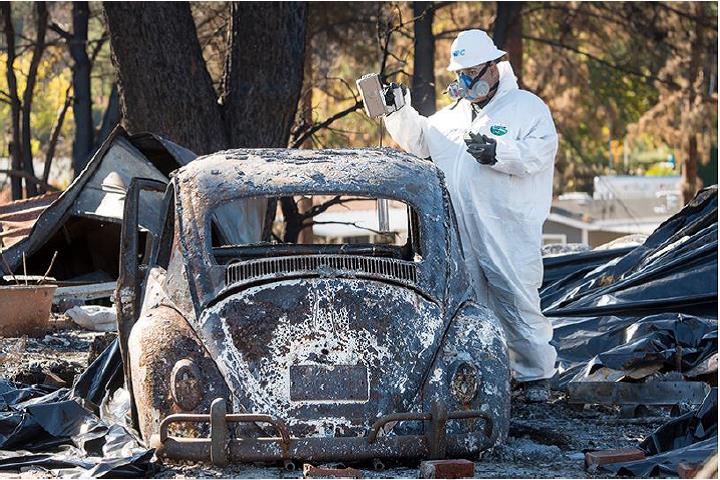
Chaparral-choked lab roads remain uncut where fire started one year ago, generating over 43,000 tons of radioactively-impacted smoke that included extremely poisonous Polonium-210
By Michael Collins
The monstrous Woolsey Fire erupted exactly one year ago today at Boeing’s Santa Susana Field Laboratory (SSFL) and began its hellacious march to Malibu. EnviroReporter.com‘s Nov. 20, 2018 exposé Smoke Screen – Woolsey Fire Contamination Cover-up determined that 43,272 tons of radiation-impacted smoke was generated by SSFL’s brush alone and sent skyward.
Now, EnviroReporter.com has discovered that some of SSFL’s most wildfire vulnerable roads appear to violate fire code due to excessive grass and brush growing up to, and in some cases through, fire roads in the southern 40 percent of the lab called the Southern Buffer Zone (SBZ). The Ventura County Fire Department (VCFD) signed off on Boeing’s brush clearance on July 4, when the SBZ was still possibly not up to code.
EnviroReporter.com has previously reported that Boeing itself found radionuclides in Woolsey Fire smoke on its property including the highly poisonous Polonium-210 (Po-210), a substance 250,000 times more lethal than hydrogen cyanide. The Po-210 was found in two separate sensors in the SBZ near where Boeing allows hikes.
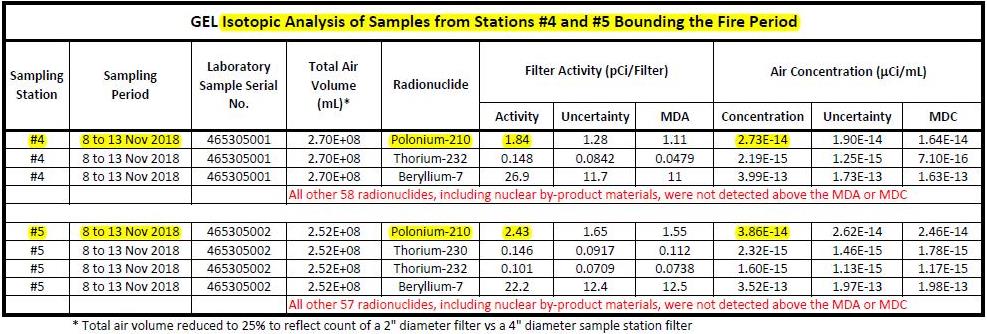
Should brush clearance at SSFL be ignored or done poorly, Southern California could again face more uncontrollable flames and smoke impacted by radiation and toxic chemicals. The former Rocketdyne facility, until completely remediated, will remain a threat to all in its fire shadow, including the tony neighborhoods Bell Canyon, Brandeis-Bardin, Runkle Canyon, Calabasas and Malibu.
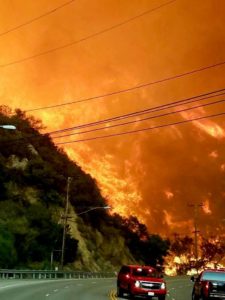
[SEE RELATED GALLERY: Woolsey Fire One Year Anniversary]
EnviroReporter.com has uncovered evidence which shows that roads in SSFL’s 1,140 acre SBZ, where the Woolsey Fire roared through Nov. 8, 2018, are lined by combustible grasses and chaparral in violation of Ventura County Fire Code. “[R]equirements are 100-feet of vegetation clearance from structures and 10-feet for road access,” according to the Ventura County Fire Hazard Reduction Program (FHRP).
Failure to keep fire roads clear of vegetation in highly prone wildfire areas like SSFL and its especially flammable SBZ make it almost impossible for fire engines to maneuver if the sides of usually one lane fire roads are aflame. That concern seemed alleviated back in July. As EnviroReporter.com noted in its July 12 feature Radiation Requiem – 60 Years After America’s Worst Nuclear Meltdown, “Fire clearance documentation showing SSFL to be in compliance with the Fire Hazard Reduction Program was issued July 4, 2019, a mere 239 days after the Woolsey Fire had swept through 80 percent of the lab with Boeing’s firefighting response virtually invisible according to local firefighters on the scene, as noted in a January 2019 Los Angeles Times article.”
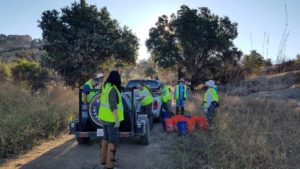
This presents a potentially grave danger to anyone living in the fire and smoke shadow of the former Rocketdyne facility where the country’s worst partial nuclear meltdown occurred in 1959, releasing more radiation offsite from an experimental reactor’s unfortified building than the partial meltdown of Three Mile Island did in 1979.
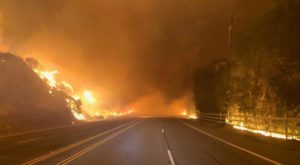
Woolsey Fire smoke sampled by Boeing had radioactive Beryllium-7 at both stations like the Po-210 as well as the radioisotope Thorium-232. Sampling Station #5 also detected Thorium-230 in the air during the fire period. In nuclear Area IV, which borders the SBZ, there existed an Advanced Epithermal Thorium Reactor according to DOE which could explain the presence of radioactive thorium isotopes.
Polonium-210 was detected at least three times in SSFL groundwater and once in soil in 1989. It is amazing that this virulent radionuclide can be detected at all considering its short half-life of 138.4 days but sources for it existed at Area IV.
New information provided April 16 by California EPA’s Department of Toxic Substances Control (DTSC), the state agency charged with overseeing the SSFL cleanup, indicates that there could be a toxic problem with SSFL ambient air without any smoke. One possible carcinogen, ethylbenzene, was found in lab air at levels 590 times the national median for the monocyclic aromatic hydrocarbon used to produce plastic. Ethylbenzene inhalation has caused kidney, testicular, lung and liver tumors in rats and mice.
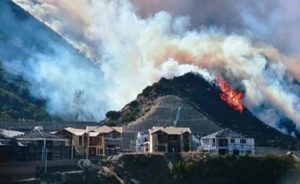
Even with EnviroReporter.com‘s July 2019 coverage of fire prevention problems at SSFL, which included extensive evidence of apparent violations of Ventura County Fire Code, subsequent photos of the SBZ show that the vegetation threat remains.
The Woolsey Fire demonstrated why safety rules at SSFL are so critical. Yet one of the only SSFL safety plans publicly available, a November 2008 SSFL Area IV Emergency Readiness Assurance Plan, tended to downplay any threats.
“Emergency preparedness and readiness at Santa Susana Field Laboratory (SSFL) is maintained at a level commensurate with the hazards,” the nine page plan said. “Funding remains adequate in view of the low hazards associated with the SSFL.”
This amazing statement was made three years after the 2005 Topanga Fire roared through the former Rocketdyne facility on its way to scorching 23,396 acres. “Low hazards,” indeed.
At least a June 2011 safety plan offered some practical advice especially important in areas where dirt lanes don’t have 10 feet of brush clearance off the side of the road. “Vehicles and equipment will not idle or park in areas where catalytic converters may ignite vegetation,” the 211 page plan read. “Workers will be aware that that the buildup of brush or grass on the catalytic converter poses a significant fire hazard.”
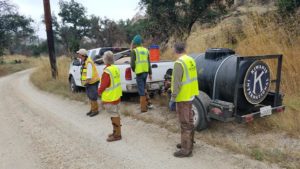
[SEE RELATED GALLERY: 2019 SSFL Continued Apparent Fire Code Violations]
Luck is not a sustainable wildfire policy but that’s what it will take if there’s no adequate brush clearance at SSFL. Before and after photos of SBZ roads since VCFD’s approval show the same unshorn plants only larger and drier. The same SBZ access road had the same weeds and plants bordering it June 27 as it did after the July 4 fire department approval as evidenced by Facebook images from August 23 and September 3.
October 16 photos document what appears to be called a “Sunset & Sip” hike through the Southern Buffer Zone with libations awaiting participants at the end of the stroll. Instead of scything golden grasses hard on the SBZ road, Boeing served golden lagers to hikers, yet another attempt by the company to sell SSFL’s contaminated land as safe.
In places where brush cutting along the road does appear to have taken place, it seems that each side of the SBZ road was trimmed out to five feet on each side, not the required ten.

This is why fire codes exist in the first place. Protecting lives, especially those of first responders, is the first priority of fire and safety rules and flouting the very basics of brush clearance defeats them entirely.
Despite the billions Boeing has lost on its grounded 737 Max planes that were involved in two fatal 2019 crashes, it still has enough money to cut brush back so firefighters have half a chance defending its contaminated property. No amount of crocodile tears and bonus cuts to overpaid executives can excuse gross and imminent endangerment of people, property and the environment.
A November 5 Facebook photo entry showed a new greenhouse-type structure recently built near the entrance of SSFL in Area I to germinate oaks for planting in the SBZ. Chaparral and golden grasses grew nearly up to the structure even though fire code dictates 100 feet minimum clearance. Apparently the Ventura County Fire Department missed this violation too.
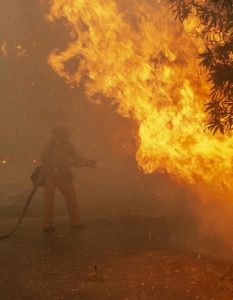
Enforcing strict adherence to the fire code could, however, save firefighter lives and resources. That way the next fire at SSFL will at least not force firefighters to forge roads blocked by flames in order to do their heroic jobs. Failing that, the public is on its own and wouldn’t be unwise in getting powerful home HEPA filter air cleaning machines and breathing facemasks rated N95 and above. And staying out of Boeing 737 Max planes.
GALLERY: Woolsey Fire One Year Anniversary
25 Years of Award-Winning SSFL/Rocketdyne Reporting
1998 – 2023
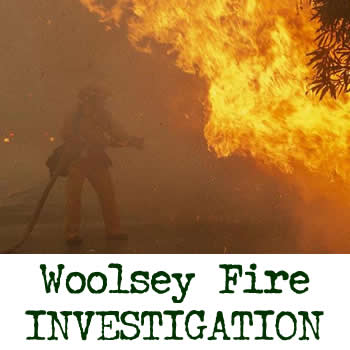












Boeing should be ashamed of their lack of morality and ethical regards to their neighbors and local public near their lab in Los Angeles, near Calabasas.
It’s their property. They need to do the right thing and cleanup. That’s just for starters. Responsibility sure is tough for corporations these days.
NBC4‘s I-TEAM did an excellent job covering the Woolsey Fire one year anniversary November 8 with a series of compelling segments including this one that includes EnviroReporter.com‘s beautiful editor, Denise Anne Duffield, (who is also my amazing wife) and Associate Director of two-time winning Nobel Peace Prize recipients Physicians for Social Responsibility – Los Angeles:
Toxic Runoff from Santa Susana Exceeded Safety Standards
Test results show that the Woolsey Fire and the heavy rains that followed spilled what some say is dangerous water, contaminated with toxic waste, into neighborhoods. Lolita Lopez reports for the NBC4 News at 11 p.m. Friday, Nov. 8, 2019. (Published Saturday, Nov 9, 2019 | Credit: Lolita Lopez)
Denise Anne appears at 2:50 –
VIDEO: https://www.nbclosangeles.com/news/local/Toxic-Runoff-from-Santa-Susana-Exceeded-Safety-Standard_Los-Angeles-564700332.html
Great article Michael as usual. You mention beryllium was found and it is in the RCRA Report that all the test stands had beryllium contamination and needed a monitoring program. Also polonium findings are shocking as very early records showed they used it. It is the lethal method that Russia uses to kill protestors.
Dear Michael,
Once again thank you for keeping us in the know about the SSFL/Boeing property. It’s such a dangerous area I can’t believe that Boeing is not living up to it’s word! Well, actually I can, Boeing has been doing everything to get out of taking care of the area it bought! If you are not going to take care of it why did you buy it? Boeing is a lazy company as attested by it’s lack of testing on the 737 jets it let fly and crash with all those souls on board. If they won’t take responsibility for it’s jets then surely the grass and weeds on the SSFL property are small potatoes to them. My concern is that my daughter and one of my grandchildren live on Woolsey Canyon Road in Los Angeles county. I am constantly worried about the lack of care Boeing persists showing to this area. Those communities are at high risk for fire. What will it take for Boeing to be responsible for their property? I don’t want it to be a fire which takes the lives of the people living nearby! BOEING DO YOU DUTY CLEAN UP SSFL and the AREA YOU OWN! Thank you again and again Michael! You are a hero to me for keeping us informed about Boeing. You’ve been on this story since the very beginning and I admire you for your work! Never give up or give in!!
Just received this from our friends at Physicians for Social Responsibility – Los Angeles:
Boeing, Dept. of Energy and NASA push plans to renege on agreements to fully clean up the Santa Susana Field Lab, point of origin for Woolsey Fire
One year after the devastating Woolsey Fire began at and burned most of the contaminated Santa Susana Field Laboratory (SSFL,) Boeing, the Department of Energy and NASA are pushing forward plans to abrogate cleanup agreements and leave most of the radioactive and chemical contamination on the site unremediated. SSFL is grossly polluted from decades of nuclear and rocket-engine testing activities including several accidents, spills, and intentional toxic releases.
On November 8, 2018, the Woolsey Fire ignited approximately 1,000 yards from the site of a partial nuclear meltdown of SSFL’s Sodium Reactor Experiment. The fire burned approximately 80% of the contaminated 2,850 acre facility before burning to Malibu, scorching nearly 97,000 acres, 1,643 structures, and prompting the evacuation of more than a quarter million people in one of Southern California’s worst wildfires to date. Three people lost their lives in the fire.
Though most media reports claimed the fire began “near” SSFL, public health advocates and community members quickly realized that the fire started on the site itself could increase public exposure to contamination in SSFL’s soil and vegetation through windborn smoke and ash and subsequently carried offsite in stormwater. Federally-funded studies have indicated higher cancer incidents associated with proximity to the site, and that contamination migrates over EPA levels of concern.
“If SSFL had been cleaned up by 2017 as DOE and NASA promised to do, communities near SSFL wouldn’t have to worry about heightened exposure to SSFL contamination from the Woolsey Fire,” said Denise Duffield, Associate Director of Physicians for Social Responsibility. “The failure to clean up the site added insult to injury for people impacted by the fire.” In 2010, the California Dept. of Toxic Substances Control (DTSC) signed legally binding cleanup agreements with the parties responsible for cleaning up the site: the Dept. of Energy, NASA, and the Boeing Company. The agreements required a full cleanup by 2017, but the cleanup has not even begun.
In December 2018, just weeks after the fire, the Dept. of Energy released its final Environmental Impact Statement indicating that it intended to break its 2010 agreement with the state and leave almost all of the contaminated soil and groundwater in its area of SSFL not cleaned up. DTSC, under the newly installed Newsom Administration, rejected DOE’s actions in a January 28 letter that stated it would hold DOE accountable to the cleanup agreement. In September 2019, DOE issued a Record of Decision for the demolition of buildings at SSFL that also violated the agreement and would result in radioactive debris being sent off to sites not properly licensed for low-level radioactive waste. DTSC again issued a firm response to DOE that the buildings may not be torn down without its approval and that DOE must comply with the 2010 agreement.
Last month, NASA released a draft Supplemental Environmental Impact Statement (SEIS) for the SSFL cleanup that proposes violating the cleanup agreement and leaving up to 80% of the contamination in its operational area of the site. NASA’s portion of SSFL is heavily contaminated with trichloroethylene, perchlorate, PCBs, dioxins, heavy metals, and other toxic chemicals that can cause cancer and other harmful health impacts.
Both federal agencies are taking their lead from the Boeing Company, which owns the most of SSFL. Boeing had long committed to cleanup to a residential standard, to also be completed by 2017. But it never even started the promised cleanup, and in 2017, however, Boeing reversed course, announcing that it would only clean up to a vastly weaker recreational standard, which would leave 98% of the contamination not cleaned up, pollution that could continue to migrate offsite and threaten nearby communities.
“Time and again, Boeing has cut corners on safety, whether on its airplanes or at SSFL, putting profits above all else. Now all three parties responsible for contamination at SSFL are breaking legally binding cleanup commitments and acting as if they aren’t under any regulatory oversight.” said Daniel Hirsch, President of Committee to Bridge the Gap. “Under federal law, DOE, NASA, and Boeing must comply with orders from the Department of Toxic Substances Control.”
While the Woolsey Fire did not trigger progress in the SSFL cleanup, it did increase public awareness of SSFL’s contamination and pressure for the site to fully cleaned up. West Hills resident Melissa Bumstead, whose young daughter has twice survived a rare leukemia, and who has mapped over 50 other rare pediatric cancers near SSFL, said, “The only positive element of the Woolsey Fire, is that our Change.org/santasusana petition, demanding 100% cleanup of SSFL, has grown to nearly 700,000 signatures. We now have many new community members involved, including the Kardashian sisters who’ve been very outspoken about the need for the full cleanup.”
Simi Valley resident Jeni Knack is one of the new cleanup advocates who also sees positive developments since the fire. “The past year since the fire has been transformative for me. In May, I even went to Washington DC to join with communities near other contaminated DOE sites to advocate for stronger cleanup policies,” she said. “The experience was empowering, and it helped lead to a letter signed by Senator Dianne Feinstein and eight California Congressmembers urging DOE and NASA to honor their SSFL cleanup commitments.”
Community members and public health advocates also noted a difference in DTSC over the past year under the Newsom Administration. “We were dismayed, frankly, by DTSC’s response to the Woolsey Fire at SSFL,” said Duffield. “They took only a handful of samples, after the fire was over and when smoke was no longer present, compared the measurements to standards vastly weaker than their own risk-based screening levels, and said nothing to see here, move along. This year, under new CalEPA Secretary Jared Blumenfeld, the agency is beginning to act more in the interest of people instead of polluters.”
Whether increased public awareness and advocacy and a new state administration will be enough to finally clean up SSFL remains to be seen. In the meantime, until the site is fully cleaned up, nearby communities will continue to be at risk of exposure to its contamination, especially during wind, rain, and fire events, which are likely to become more frequent as the global climate crisis impacts California.
# # #
Physicians for Social Responsibility-Los Angeles advocates for policies that protect public health from nuclear and environmental threats and eliminate health disparities.
The Committee to Bridge the Gap is a non-profit nuclear policy organization focusing on issues of nuclear safety, waste disposal, proliferation, and disarmament.
Parents vs. SSFL is a grassroots group of concerned parents and residents who demand compliance with cleanup agreements signed in 2010 that require a full cleanup of all radioactive and chemical contamination at the Santa Susana Field Laboratory.
What we need is a whistleblower! Oh wait, we already have one! And Michael Collins has been blowing that whistle as long and as hard as he possibly can! He’s blue in the face, but that doesn’t seem to matter to entrenched special interests and politicians who know they can keep blowing smoke up you-know-where! I wonder whose smoke is more deadly and toxic. SSFL’s, or those faceless bureaucrats and politicians who continue to accept Boeing’s pronouncements of low hazard and acceptable risk? Both are deadly. And public indifference? Clearly, it’s the deadliest of all.
Keeping the fire burning, literally, Michael – good work!